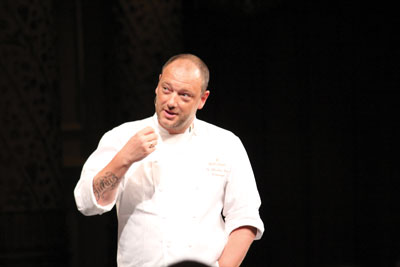
The taste of tomorrow
January 31, 2013
By
Laura Aiken
What do today’s consumers want? What will they want tomorrow? Puratos shed light on this very issue by sharing the results of its global research at a two-day conference focused on innovation.
What do today’s consumers want? What will they want tomorrow? Puratos shed light on this very issue by sharing the results of its global research at a two-day conference focused on innovation. The event, called Taste Tomorrow, held Oct. 18 to 19 at the storied Drake Hotel in Chicago, brought together some of the most forward-thinking minds in the food business. Here is Bakers Journal’s roundup of highlights from the event.
 |
|
| A rather high-tech traditional tea service offered on break at Puratos’ Taste Tomorrow event.
|
The results are in
The Taste Tomorrow event kicked off with the presentation of 10 “mega-trends” Puratos derived from its global study, research that touched down in 14 countries on four continents and queried 6,400 consumers. Overall, it was confirmed that consumers are sending inconsistent signals.
- Food future: A person’s positive or negative attitude about the future of food depends on whether he or she is from an emerging or a mature market. Seventy-six per cent of respondents in China said they viewed their food future as healthier, with better quality, and India expressed similar sentiments. Italy, France and North America had a more pessimistic view. There was a global consensus that nutrition is a key aspect of the value of food. People are all about “naturalness.”
Bakeries could look to narrow the gap between manufacturing, producing and selling because customers want to feel like the food was just made. Health is about look and feel, packaging, presentation and point of sale, said Karel Zimmermann, regional director North America for Puratos, adding that it’s not rationale but subjective perception.
People are scanning labels for health cues, he said, but not reading in detail. - Overall quality perception: In mature markets, brand is not enough proof of quality anymore, although 45 per cent of Canadians said they preferred well-known names. How does a bakery boost quality perception? Make it a multisensory experience, said Zimmermann, and tell compelling stories. Consumers want it all but want there to be a balance between quality and price.
- Storyselling: Without a doubt, the overarching theme that surfaced over and over again at this conference was the concept of storyselling. Customers want to feel the passion behind the products no matter how the goods are produced, which means putting a face to a specific piece of pastry even in an industrial setting. Packaging is an excellent medium for selling the story, said Zimmermann.
- Global versus local: What you eat tells something about yourself, and people are highly emotionally involved in the eating and buying experience. While the local movement has received a lot of attention of late, preferences are pretty split between global and local choices. The global consensus saw a coexistence of local shops for authenticity and supermarkets for convenience.
- City brands: Consumers are digging products like New York bagels, Bombay naan, and Parisian macarons. City brands present an image that guarantees tradition, quality and know-how. Currently, emerging markets are a hot spot to export your city brands. In Canada, the level of interest in city brands was 5.3/10. Canadians seem to emerge in this study as the most skeptical country polled.
- Tradition: Tradition is future-proof. Roughly an equal number of consumers want traditional recipes as want to try something new. This means people want variety, so hold on to your traditional classics but still experiment.
- Mobility: There is a great blend of pleasure and convenience that is needed these days. In Canada, Puratos found that one in five consumption moments for bread occurs when consumers are on the go. Fresh bread delivered at home or work was the best-scoring concept in the study.
- Health: People are interested in healthy products, but not when it comes to their indulgences. The more often people eat something and the larger the quantity, the more interested in the health aspect they are. Small bites for pleasure ought to remain decadent. The study found that 61 per cent of American consumers tend to snack on smaller high calorie products such as chocolate/patisserie. Thirty per cent of Americans tend to make impulse food purchases.
- Authentic bakery feeling: People want a unique experience and the most successful supermarkets are ones that create the artisan feel. For eighty-one per cent of consumers, the smell of fresh baked bread makes them tempted to buy it. Combine your uniqueness, story, history of the recipes and the possibility to smell, see and taste, to create the authentic bakery feel, said Zimmermann.
- Bakeries of the future: There is a demand for bakeries to specialize in a certain top selling product and then let customers customize it. When given more choice, consumers feel it’s more personal and exclusive, said Zimmermann. He suggests local shops go beyond your traditional selections and become more of a mini market to appeal to people’s desire for convenience.
 |
|
| Attendees get their networking groove on over bits and bites
|
Innovation through Food Pairing
Bernard Lahousee, founder of Sense for Taste, www.foodpairing.com and Foodpairing/Insites Consulting, led a breakout session on how his food pairing system can bring you new and exciting flavour combinations. Lahousee demonstrated you can have meat flavour with no meat, and shared that you can use umami to add saltiness without adding the salt. In a product there may be 800 flavour components, he said, but only 80 that are really important. The Foodpairing flavour map works basically by having one central flavour in the middle, and then several branches of bubbles around it that are complimentary and you just keep mixing and matching. This system is how renowned chef Heston Blumenthal came to combine jasmine and foie gras.
Tradition versus Innovation
Frederik Lievens, business unit director for Puratos Group, hosted a breakout seminar that explored one question: Is the future tradition or innovation? Consumers don’t know, said Lievens.
But they do know a few things. He said they want “more good, less bad.” This means foods should have more fibre and probiotics, be cheaper and easier, but contain less sugar and fewer fats. People need more farm to fork training to understand where food comes from and how it is made, he said, adding that quality is a way of life for the future and that’s where innovative emphasis can lie. Must and want are completely different buying choices, he noted. Be creative and tell stories to drive the price up. Develop more products for breakfast opportunities.
Gluten-free is a different kind of manufacturing, said Lievens. “It is making a lot of noise but still a very small player in the global market.”
 |
|
| Dominique Persoone had the audience applying chocolate lipstick before the night was out. Photo on right courtesy of Puratos.
|
An evolution of food consciousness
John Mackey, co-founder and CEO of Whole Foods Market, shared his insights into how Whole Foods built its brand and what consumers are telling the company. His customers are foodies, and those customers have helped turn Whole Foods into an $11-billion company.
Mackey’s food revolution paints food as a pleasure where quality and taste are the highest values and the story matters greatly. Food is a type of self-expression, he said.
“The natural food movement is a romantic reaction to the myth of the corrupt industrial food system,” he said. There is a need, he said, to synthesize the pre-industrial and industrial ages of food production.
He addressed the challenges of the buy local movement, citing it as more expensive, not necessarily organic nor a guarantee of the humane treatment of livestock. There is a risk of community-based selfishness, he said, where communities, caught up in the romanticism of supporting local farmers, may be hurting poorer communities by not purchasing their goods. Advocates greatly exaggerate the fossil fuel savings, he said, using the example that it takes less fossil fuel to bring rice to San Francisco from Bangladesh than it does to truck it down from northern California. Mackey said he sees the ethically traded food movement as gaining steam.
The session ended with a conversation on the healthy foods. Mackey said the trend towards natural and healthy is both challenge and opportunity but chocolate and patisseries “shouldn’t even try. It’s about indulgence. People are not going to stop indulging themselves.”
A member of the audience asked Mackey why it is that healthier foods cost more. He said that is a myth.
“We can afford to eat healthier foods we just choose not to. Our taste buds have been corrupted.”
On the flip side . . .
Bob Marshall, vice-president, U.S. operations, for McDonald’s, spoke on the heels of Mackey in an intriguing juxtaposition of two different sides of the food business (albeit this one is surely no less profitable). McDonald’s stocks have gone from $12 to $102 in the last 10 years. McDonald’s does 73 billion a year in sales worldwide, said Marshall. He identified the key components to McDonald’s success as quality food, service, value prices and a good look. Relationships form the backbone.
“Suppliers, McDonald’s, and owner-operators are the three-legged stool and all the legs need to be the same length.”
McDonald’s makes over $15 billion a year in purchases all on a handshake – no contracts, he said. McDonald’s also makes its suppliers part of a transparent planning process.
Marshall offered two particularly memorable “Bobisms,” as he referred to them:
- “When left to their own devices, companies will do more than they can, more than they should, to the detriment of the company.”
- “What got you here won’t get you there.”
Blue oceans
John Riker of the Blue Ocean Initiative Center in London presented an introduction to Blue Ocean strategy and value innovation logic. In short, Blue Ocean strategy is about creating new uncontested market space rather than figuring out how to compete within the existing space. The Blue Ocean book was the first business book to reach $1 million in sales, said Riker. Blue Ocean strategy helps businesses identify the elements on which the industry competes and determines which ones to eliminate, reduce, raise the bar in and create entirely new. Cirque du Soleil’s reinvention of the circus was used as an example of how this can be done. To find out more about Blue Ocean strategy, visit the Canadian website at http://blueoceanstrategycanada.com/ .
 |
|
| Attendees painted on chocolate lipstick by Dominique Persoone.
|
The ‘Shock-o-latier’
Guests of the conference were treated to quite the chocolate pairing by renowned chocolatier Dominique Persoone, self-described shock-o-latier and cofounder of The Chocolate Line. Chocolates were delivered to guests at tables with scented vials on them, which were spritzed into the air prior to biting into the sweets. Chocolate with grassy notes was quite memorable, as was a chocolate called Rain that felt like a waterfall burst in your mouth when you bit in. But perhaps most intriguing, was a chocolate that arrived with a little tube of tequila stuck in it and a dot of salt on the side. Knock back the tequila, lick the salt and bite the chocolate. Now that’s a flavour punch.
The face of today’s consumer is a paradoxical one. They want it all, is the summation of Puratos’ research. This challenge will likely drive some of the greatest invention and innovation in the bakery industry. These are interesting times indeed!
Print this page
Leave a Reply